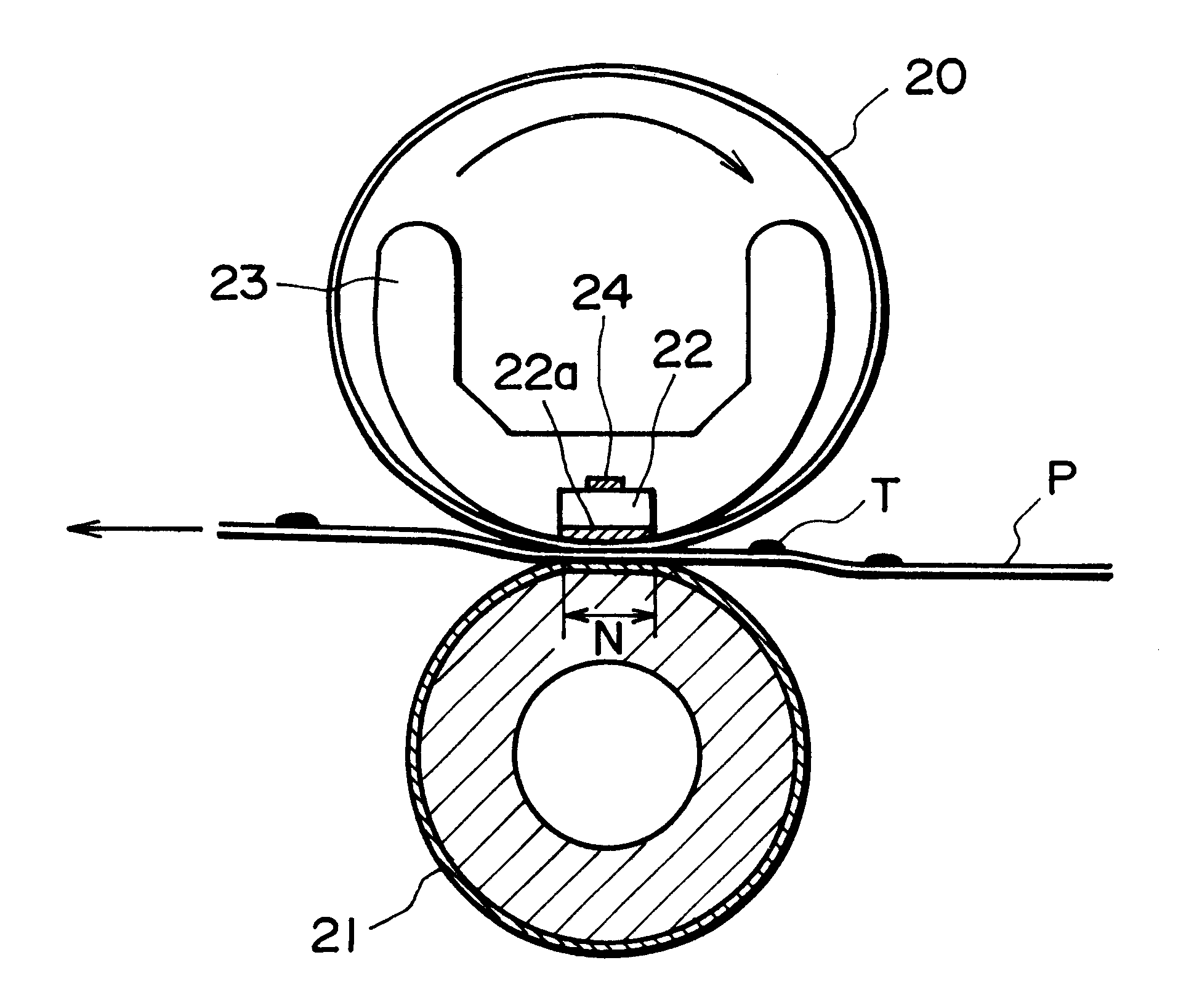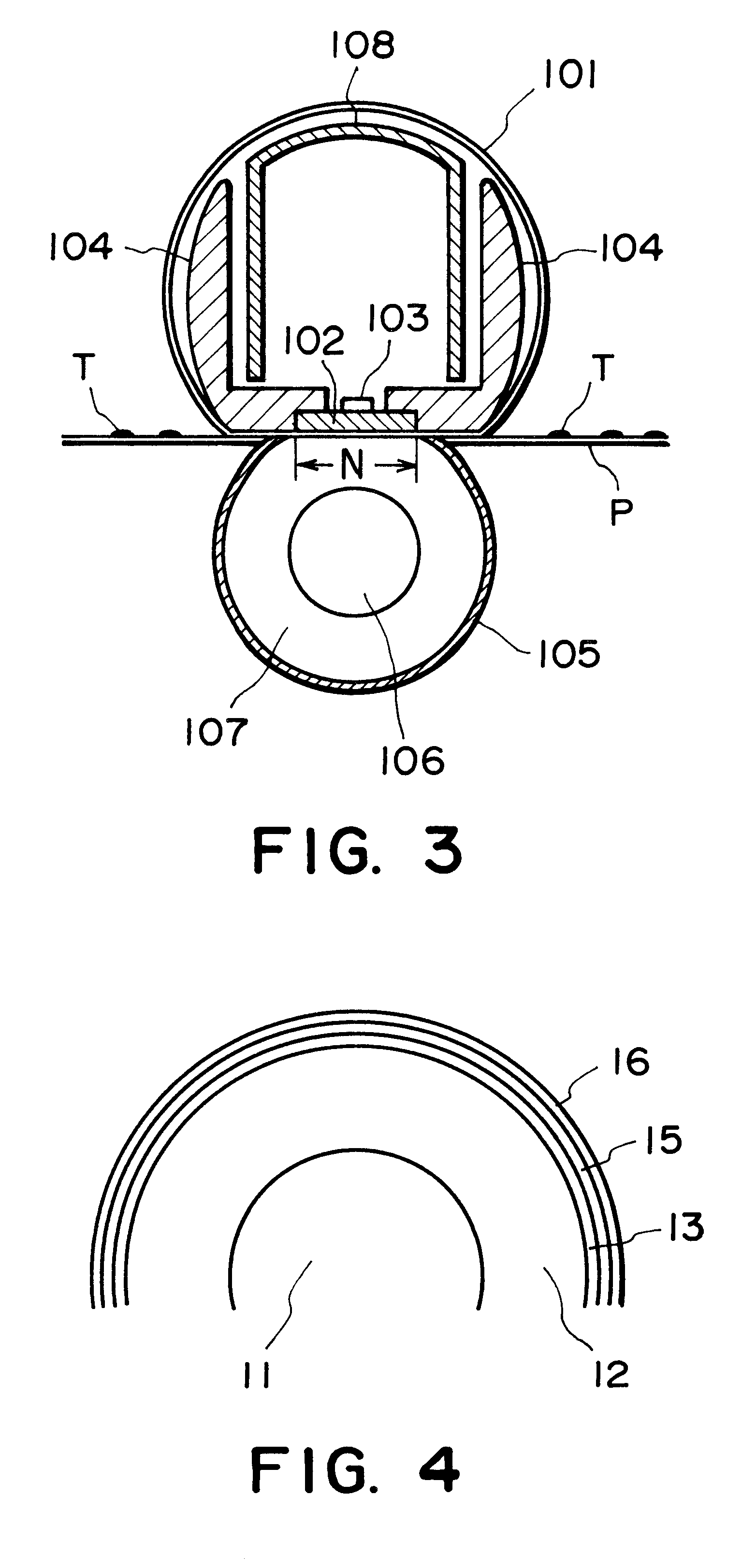Fluorine-containing resin-coated pressure roller and heat-fixing device
a technology of fluorine-containing resin and pressure roller, which is applied in the direction of electrographic process apparatus, instruments, optics, etc., can solve the problems of paper dust attachment, paper wrinkles and paper winding around, and the surface of the roller is liable to be soiled,
- Summary
- Abstract
- Description
- Claims
- Application Information
AI Technical Summary
Problems solved by technology
Method used
Image
Examples
example 1
Four pressure rollers (Examples 1-1 to 1-4) each having a structure as shown in FIG. 1 were prepared as follows.
A 2 mm-thick aluminum core cylinder was coated with an elastic layer of silicone rubber ("DY35-561A / B", mfd. by Toray Dow Corning Silicone K.K.) in a thickness of 2.5 mm, a length of 225 mm and an outer diameter of 20 mm). After being treated with a primer, the coated cylinder was further coated successively with an adhesive layer of a fluorine-containing rubber / fluorine-containing resin mixture and a release layer of fluorine-containing resin having thicknesses shown at Examples 1-1 to 1-4 in Table 1 appearing hereinafter. Each adhesive layer was formed by application of a solution in methyl isobutyl ketone of the following formulation A, followed by drying and curing. The formulation A after curing exhibited a hardness of 90 deg.
Formulation A
The surface release layer was formed by application of an FEP dispersion liquid ("ND1", mfd. by Daikin Kogyo K.K.) followed by dryi...
example 2
Two pressure rollers (Examples 2-1 and 2-2) were prepared in a similar manner as in Example 1.
More specifically, an aluminum cylinder coated with a silicone rubber layer and a primer similarly as in Example 1 was further coated with an adhesive layer (of a fluorine-containing rubber / fluorine-containing resin mixture) and a release layer of fluorine-containing resin having thickness (at Example 2-1 or Example 2-2) in Table 2. The adhesive layers in Examples 2-1 and 2-2 were formed by application of solutions of the following formulations B and C, respectively, followed by drying and curing. After curing, the adhesive layers exhibited JIS-A rubber hardness of 73 deg. and 70 deg., respectively.
Formulation B
Formulation C
For each pressure roller, the surface layer was formed by applying a PFA dispersion liquid ("AD-2", mfd. by Daikin Kogyo K.K.), followed by drying, baking and a surface-smoothing treatment at 300.degree. C. for 3 min. otherwise in the same manner as in Example 1. The sur...
example 3
Though Example 3 and Comparative Examples 2 and 3 were described above as representative, but other pressure rollers were also prepared by using various thicknesses of adhesive layers and surface release layers and degrees of surface-smoothing treatments. The results of performance evaluation in the above-described manner are summarized in FIGS. 5 and 6. More specifically, FIG. 5 shows the performance evaluation results on a graph with an abscissa of roller surface hardness and an ordinate of contact angle with water. In FIG. 5, each spot .smallcircle. represents that toner soiling did not occur until 5000 sheets, each spot .DELTA. represents that toner soiling occurred at 3000 sheets, and each spot X represent that toner soiling occurred even at an initial stage. As is understood from FIG. 5, toner soiling prevention characteristic is inferior at a contact angle of ca. 105 deg. or below. However, even at a contact angle of 105 deg. or higher, the toner soiling prevention characteri...
PUM
 Login to View More
Login to View More Abstract
Description
Claims
Application Information
 Login to View More
Login to View More - R&D
- Intellectual Property
- Life Sciences
- Materials
- Tech Scout
- Unparalleled Data Quality
- Higher Quality Content
- 60% Fewer Hallucinations
Browse by: Latest US Patents, China's latest patents, Technical Efficacy Thesaurus, Application Domain, Technology Topic, Popular Technical Reports.
© 2025 PatSnap. All rights reserved.Legal|Privacy policy|Modern Slavery Act Transparency Statement|Sitemap|About US| Contact US: help@patsnap.com



